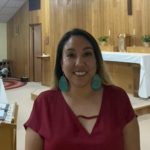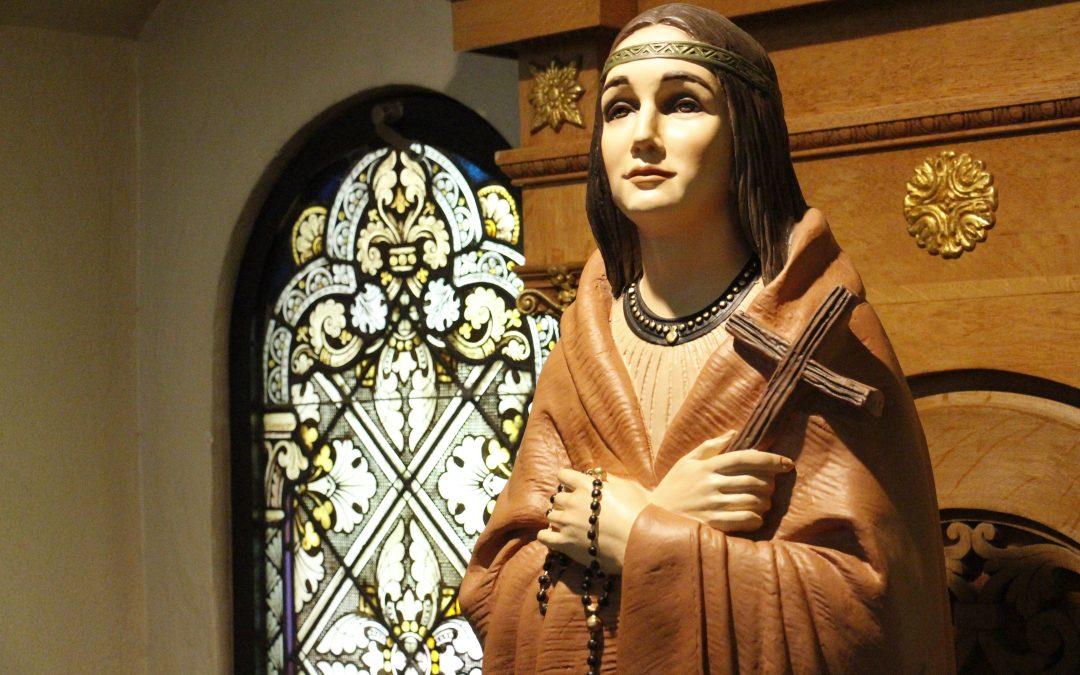Bridging the Gap Between Navajo Tradition and Catholicism
By Teresa Rojo Tsosie.

Before I begin my personal reflection on St. Kateri Tekakwitha, I would like to introduce myself in Navajo. In my Navajo tradition, it is customary that we introduce our clans. The clan system was created by Changing woman. She wanted for us as Dine to be able to have family no matter where we travel on this place we call Mother Earth.
Hello! I am Teresa Rojo Tsosie. I am Mexican born for the Blacksheep clan. I live in Tuba City, Arizona which is on the Navajo Reservation. I am currently the pastoral assistant to my parish of St. Jude Catholic Church. I am also currently our Kateri Circle leader. Kateri Circle is a group of faithful Catholics/non Catholics who have a devotion to St. Kateri Tekakwitha. Once a year those in these circles meet at the Tekakwitha conference.
In reflecting on my personal journey and or relationship with St. Kateri Tekawitha, I do believe she has always guided me throughout my personal faith relationship. Growing up Native and Catholic for most of my life had been relatively “easy”, but as I got older and the discovery of the mass graves in Canada and in the United States had been national/world news. I found myself at a crossroads.
St. Kateri Tekawitha is the first Native American Catholic Saint. Born in 1656, in the Mohawk village of Ossernenon. At four years old she contracted smallpox, which left her face severely scarred. With her whole family succumbing to smallpox, she went to live with her uncle who was the chief of the Mohawks. At age 19, Kateri converted to Catholicism, with the vow of Chastity and promising her life to Jesus. This decision of course was not welcomed by those of the village she was living in. Rumors had started she was into witchcraft, to avoid persecution, she traveled to a Christian Native community in Montreal. In December 2011, after the testimony of a young boy whose infection was cured by having prayed to Tekakwitha for her intercession, Pope Benedict XVI recognized Tekakwitha as a saint. She was canonized the following October.
Being a person who identifies with two traditions, it is hard to not see both sides of the conflict. One moment that always sticks out for me, is when after watching the movie Indian Horse, which I do recommend to everyone who reads this reflection. It’s about the boarding schools in Canada which are Catholic, and an Indigenous boy who found solace in playing ice hockey. Unfortunately, he was abused, and the movie showcases the aftermath of the abuse. After the movie, my good friend at the time asked me how I felt, because she knew I was catholic. I told her, I was okay because I, for some reason, could always separate the two. The abuser and the priest. That was not a man of God spreading the good news of the gospel but a man who did these things for his own selfish reasons. During these times of conflict and struggle with being both Native and Catholic, I always turn to St. Kateri. I often wonder how difficult it was for her, to know she had this profound love for the Eucharist but yet still wanting to be a part of her traditional Native culture.
St. Kateri Tekakwitha, is the patron Saint of Ecology, who I believe is perfect for this. Growing up we are always taught to take care of mother earth, and in return she will take care of us. When I was approached to help create the Wholemakers curriculum, along with three other AMAZING women. I jumped at the chance, not only because I was a woman but you cannot take into consideration the impact indigenous people have on ecological spirituality. You cannot make anything involving Laudate Si without the participation of an Indigenous person.
In helping create this curriculum, it brought me closer not only to my catholic faith but also to my Navajo tradition. This has really helped me bridge the gap between being Navajo AND Catholic. Often, I am told by many in catholic circles “you can’t be both ”. One is going to be lacking in the other. When I do find myself struggling, I talk to my sister in Christ, St. Kateri Tekakwitha and I ask her for guidance and to give me HER strength. She walks with me everyday as I am proof you can be Native and Catholic. There is no in-between or conflict. You can be faithful to our Catholic faith but still have a strong connection to your Indigenous culture.
Kateri is often referred to as “Lily of the Mohawks” in recognition of her kindness, prayer, faith, and heroic suffering. This can relate to as well as Jesus Christ, and how we each strive to live our faith as Jesus did. But for me I not only try to live out my catholic faith as Jesus but as Kateri Tekakwitha as well. Her strength and love for Jesus should be something we each need to take into account for in our lives. In everything we do! We are reminded of Christ’s suffering each Sunday at Mass. Without suffering how do we become closer to our faith? To God? To each other? Look to your own faith journey and see how you can relate to St. Kateri Tekakwitha, in what ways can she help you be closer to Jesus Christ or taking care of Mother Earth?
My personal story and love for St. Kateri Tekakwitha is one I can never fully explain. She has guided me along with the women in my family to be the strong Mexican Indigenous woman I am today. To know Kateri Tekakwitha is to know me. Without her guiding me, I would not have the strength or courage to tell my story each time I am asked. I thank her every Sunday for helping me. For those reading this, please include in your prayers St. Kateri Tekakwitha. Look to her when you find yourself at a crossroads with faith, or wanting to care more for creation. In order for Mother Earth to heal and take care of us, we need to take care of her.
Ahéhee (Thank you!)
My Brothers and Sisters God Bless!
Teresa Rojo Tsosie is currently living in Tuba City, Arizona, on the Navajo Reservation, and is a Member of the Navajo Nation. She is Pastoral Assistant at her local parish St. Jude Parish and manager of Communications in the Diocese of Gallup. In addition, Teresa is a consultant for the Catholic Climate Covenant, collaborates in the young adult process of Journeying Together, and is involved on various lay boards within the United States Catholic Conference of Bishops.

Recent Comments